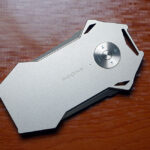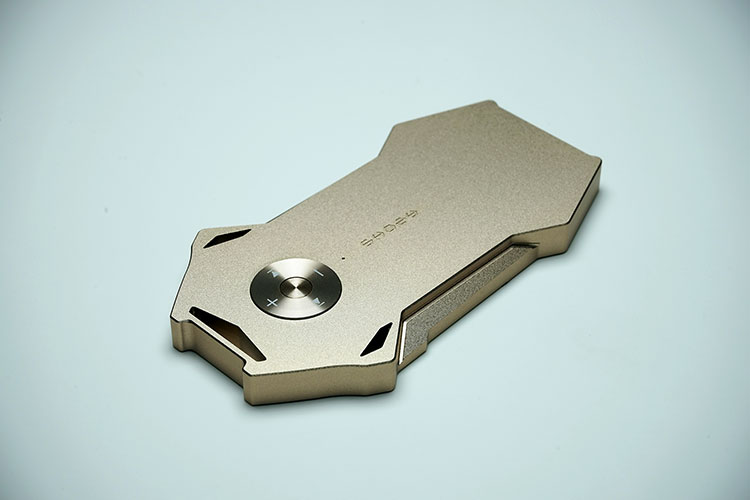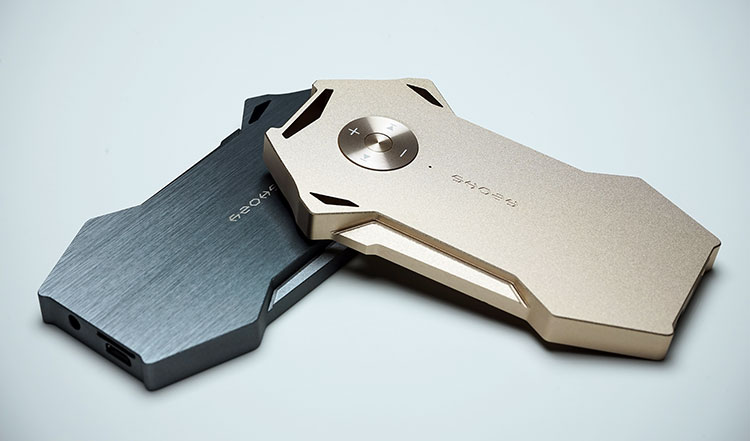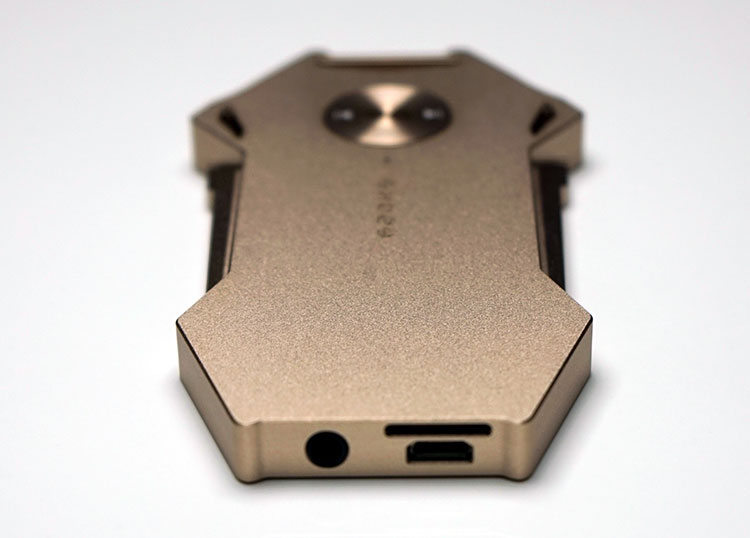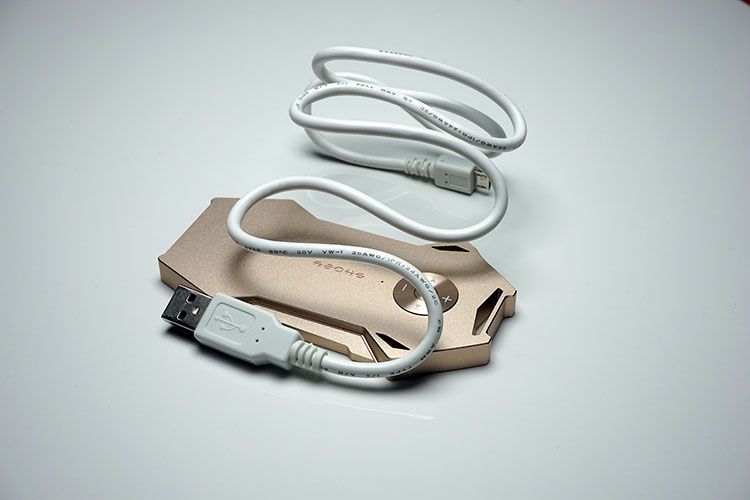Today, we review the Shozy Alien DAP Gold Edition, which is a 24bit/96kHz capable digital audio player with a very unique screen-free interface. It is priced at $200, (approximately).
Disclaimer: This sample was sent to us in exchange for our honest opinion. Headfonics is an independent website with no affiliate links or status. We thank Shozy for their support.
Click here to read more about SHOZY gear that we have previously covered on Headfonics.
Note, that this article follows our latest scoring guidelines which you can read here.
The Alien DAP by Shozy is a DAP I should have given a dedicated review to ages ago. Instead, you have been seeing it pop up in comparisons to other DAPs as well as matchability ratings for IEMs.
So when Shozy asked me if I wanted to review the new Gold Edition a few weeks ago I thought it better I do this quickly, redeem myself in the process so to speak, as well as introduce you to one of the best-sounding DAPs you will ever hear for the paltry price of $200 (approx).
What is the Pitch?
Sans Screen
The Alien is an apt name indeed and the Gold Edition is the third such revision in a line-up that has yet to even consider the concept of a visual screen as relevant in creating a music player in today’s “poke, play, and listen” generation.
It sort of reminds me of asking waiters to take a picture with a camera in 2016. Explaining the concept of a physical button that you semi-press to get a focus and then fully press to take a shot is rather pointless as you watch them instead ask where you press on the LCD screen.
For some, the LCD screen is THE point of a phone, camera, or music player, well at least a major talking point on whether or not it is worth buying. It simply misses the core point.
Does it help you take great pictures, help you make quality phone calls, or quickly send text messages? The bread and butter as I call it. In the case of a music player with an LCD screen does it help make your music sound better? In short, no it does not.
We can, of course, argue that the LCD screen makes the user interface easier to use and understand (though not in all cases).
We can also say you can access lovely things like EQ customization with an LCD screen and check your media library to select the exact song you want to listen to at the right time. It is rather pointless though if you do not like how that DAP sounds after paying a lot of money for it.
Ala Shuffle
The Alien has no screen and operates in much the same way as the old Apple iPod Shuffle and looks more like the top side of the Battlestar Galactica or weapon most likely to be brandished by some sort of Ninja.
It has no place in today’s visually obsessed society, not by a long margin, but in ditching the visual distractions it can offer what Shozy claims is a class-leading sound and way above what they are charging for it.
I also believe that Shozy has been rather clever in that aspect because without the distractions you only have the music and listening to the music has become a dying art in this gear-obsessed era.
Costs
Also, by ditching an LCD screen, Shozy has been able to keep the costs lower or more focused on processing, decoding, and amplification. In their estimation, people who buy The Alien will buy it based on getting those fundamentals right more than cool album art.
The first two gens were a success in that respect. The third keeps the same philosophy but is designed to address some of the quirks within the sound of the first one and some design aspects.
It is a little bit more expensive than the original version and they are not releasing too many of them, perhaps in the 100’s at most so if you can grab one now I suggest you do.
Design
It is like no other DAP you have used before. It lacks a physical screen, does not conform to standard dimensions and form factors of other DAPs, and has no fancy functions such as a balanced output, line out, or bass boost.
In that respect, the Alien is an incredibly simple device. Constructed of CNC machined aluminum, the Alien Gold edition has gone through some subtle changes from the original editions that came in brushed silver and black.
Both retain that same lightweight appeal measuring in at around 80g in weight so it’s very portable and fairly pocketable.
I say fairly because the shape of the Alien does have some rather odd angles and bulges and in the case of the previous generation silver edition, you could consider it a bit sharp in the hand, especially if gripped tightly.
The Gold Edition has the same form factor but this time, the machining process has produced a bit of a more rounded feel to the angles and curves of the chassis. As such it is more comfortable in the hand and possibly in the pocket also. It is a very subtle visual change so kudos for Shozy paying attention to this one.
Front & Back
Both the silver and gold edition Aliens have the same front and back panels with the same features. Both have flush flat back panels with the Alien moniker, serial number, and where it is made and by whom.
If you wish to lift the lid of the two-piece chassis you can do so with a T5 screwdriver on the four small colored coded screws on the back panel.
On the front panel just above the central Shozy logo, you have a small LED light to indicate power, playback status, and battery levels. Just above the LED and housed into the chassis is the main playback functionality on a circular disc. Each side has a specific operation as follows:
Just above the LED and housed into the chassis is the main playback functionality on a circular tactile disc. Each side has a specific operation as follows:
- Left-back one track, long press left – back to previous album or folder
- Right – forward to next track, long press right – forward to next album or folder
- Top (+) – volume up, long press + – pause
- Bottom (-) – volume down, long press once and you repeat the album, long press twice brings you back to default mode, 3rd equals shuffle, and 4th once again takes you back to default mode.
Fluidity
Now between the silver and the gold edition Aliens, there is a small but important difference to the fluidity of each button when pressed.
On the Silver edition, there is more resistance when pressing followed by a click sound when engaging. It feels like a two-step process whereas the gold edition is less resistant and without the secondary click stage.
It is smoother and feels like a one-step process. As a result, the gold edition of the Alien feels more fluid and also a little faster in operation when compared to the silver edition. Just that bit more refined is the phrase that comes to mind.
Top & Bottom
Forget the top, it’s got a bit of a lanyard going on there for some straps and whatnot but not much else; it’s the bottom you want to have a little look at instead.
What a simple little bottom it is too and all with a single 3.5mm headphone jack out on the left and on the top right a single microSD card slot and just below it the USB port for charging.
The USB is only for charging, there is no DAC out or OTG function but the good news is the microSD slot can handle 128GB microSD cards, and I presume upwards, so there is no artificial limit that I can tell off with regards to memory size although there are some OS limits on file numbers within folders during playback.
Now whether or not a 128GB microSD card is suitable for a non-display-based DAP is debatable but it is there if you want it or need it. Note though the official file limit is 32GB listed on the back of both Alien boxes.
One difference or slight upgrade I did notice between the gold and silver editions was the size of the 3.5mm jack on the gold, which was a bit bigger than the silver edition. The gold edition also has an additional insulator ring inside the jack port which the silver edition does not have.
Functionality
It is not exactly War & Peace in terms of functionality, more like a Ronson advert because it does exactly what it says on the tin and that’s play music out to your headphones and nothing else. Now there’s an idea.
Since there are no onboard drivers on the Alien series you cannot load it onto your PC or MAC as a storage driver and load music directly to any microSD card.
You will need to either slot it in an SD card adapter and into your PC or through an external card reader and load files in any manner you like. You can either load it via a media library and sync it or simply drag and drop it. Once completed simply eject and stick it back in the Alien and fire it up.
Decoding
Now interestingly neither of the Aliens work with compressed or lossy files. They work with just two formats, Wav and Flac, which are lossless.
Even with these two formats it is not a free-for-all in terms of bitrate either with Wav compatibility only up to 24bit/96kHz and Flac having a top rate of 44.1k. If you have anything higher it will not work.
If you are used to MP3, it will not work, if you have a ton of Alac, OGG, etc… well you get the idea. It is a limitation that will likely see a few people thumb their noses down in favor of something with a wider range of codec playback and that is something I can well understand. However, I have plenty of Flac so hoorah for me.
Amplification
Both the silver and gold edition Aliens pack the same amplification specifications with both outputting at 2*55mW into 16Ω. In theory, it should show enough dexterity to handle both IEMs and portable headphones up to 32Ω and it can get pretty loud when it needs to get loud.
The signal to Noise Ratio is around 98 dB on both Aliens. Ideally, I would like to see it creep up to around 110 dB+ where the majority of DAPs tend to perform but since the dynamic range of 16BIT files is normally around 96 dB.
However, this might be a moot point unless you substantially crank up the volume, wear highly sensitive IEMs, or the performance to the official rating is not as accurate. It may be an issue on 24BIt Wav files though I have none to test that out so please feel free to chime in.
Hiss was present on the silver edition of The Alien as does distortion at very high levels on demanding headphones. The more sensitive the IEM the more hiss you heard.
Thankfully the Alien gold edition has reduced a lot of that hiss though it is still present. Now whether or not they tinkered with the positioning of the volume control I am not sure, it is still there, just slightly more subdued and more tolerable. This is a subtle hiss more than a blaring hiss.
Battery
For such a simple creation, semantically speaking, the Alien has a battery life of around 8 hours. It’s decidedly in the DX90 territory of lifecycles and without a replaceable battery also so this is not a killer spec.
Mind you, both Aliens are running off a 1220mAh li-poly battery which is not big but then again neither is the Alien so this might be as good as gets physically and technically.
Factor in a decent amp stage and lossless decoding then 8 hours sounds about ok. Then again you have no GUI, balanced out, line out, DAC function, and all of sudden those ‘other mortal DAPs’ suddenly seem all the wiser for having bigger batteries.
I am sensing compromise here from Shozy. A balance between the form factor, the decoding rates, and what is physically possible to fit inside.
Accessories
Both Aliens come in the same packaging which is, to my mind a rather mysterious little plastic box with a foam inlay and a large white USB cable underneath as your only accessory.
The mystery is when you actually try and put everything back in the box after you take the Alien out. It’s almost impossible to get the paper sides to fit inside again without some sort of bending, folding, and ripping effect.
It is a curiosity to be sure, though hardly relevant unless, like me, you suffer from OCD.
UI
The user interface of both Aliens is entirely physical and located on the front panel. There is no difference in both the silver and gold editions operating in terms of playback control and file navigation.
All the details on how each button works are contained in the previous description of the front panel. It is a fairly rudimentary UI in all respects but what it does is it does well without any hitches, freezes, or bugs.
Shozy has chosen this path to place more emphasis on processing the codecs and producing a good signal rather than splicing it up and losing some to a GUI.
Boot
Because of the lack of a software interface, the boot of the Alien is almost immediate and though there is a short delay of about 1-2 seconds it will start to play the first song in the first folder on any memory card. You can elect to pause this by long pressing the volume up button and then pressing it again to restart where you left off.
Controls
The central button acts as the power-up and power-down button. Once pressed though the Alien has no default memory functions so out goes whatever volume and position you had previously. It will simply start as the default volume and first track on the card once you power it up again.
This can be a frustrating experience the first few times but if you have a fairly good idea of where you were then powering it back up and skipping to where you left off then it is not too difficult to get back there.
Folder Management
You can load as many folders as you like onto your memory card but important to note that there is a 99 file limit within each folder. I suggest you load by album to keep it simple.
Neither Alien will manage playlists or create any favorites or playlists on the fly. If you want to control how the Alien selects which folder or track to play next I suggest numbering your folders as you load them onto your memory card and the same with each track within each folder.
If you have good tagging software this shouldn’t be an issue. Just a further note, folders within folders are a no-no with both Aliens: it simply will not read the sub-folder.
Click on page 2 below for our sound impressions and selected comparisons.


